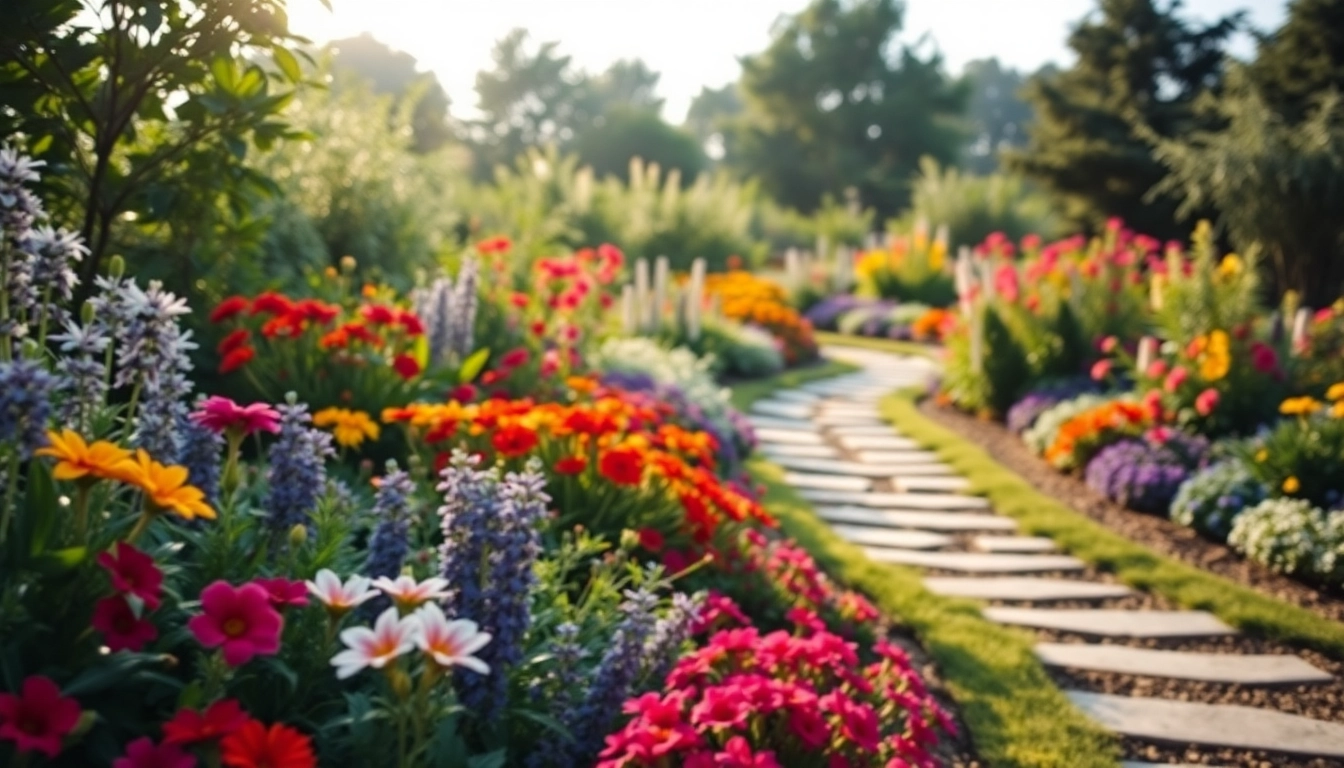
Enhancing Outdoor Spaces: Professional Landscape Design Service for Every Need
Understanding Landscape Design Services
What is a Landscape Design Service?
A landscape design service involves the planning and design of outdoor spaces to create aesthetically pleasing and functional environments. These services can range from residential backyard makeovers to large-scale commercial projects. Landscape designers work to enhance the visual appeal of a property while considering factors such as climate, soil type, and existing flora and fauna. They may provide a variety of services, including site analysis, plant selection, layout design, and project management. By employing a landscape design service, clients can ensure their outdoor areas are tailored to their needs, style, and the local ecosystem.
Benefits of Professional Landscape Design
Engaging a professional landscape designer offers numerous benefits for property owners. Firstly, it ensures expert guidance in creating outdoor spaces that maximize both beauty and functionality. Professionals have extensive knowledge about horticulture, design principles, and sustainability practices, allowing them to make informed decisions that enhance the property’s value. Additionally, professional designers are adept at navigating regulatory requirements and can handle permits, ensuring compliance with local laws.
Furthermore, well-executed landscape design results in improved outdoor usability. Features such as patios, walkways, and gardens can be strategically placed to create inviting spaces for relaxation, entertainment, or recreation. Investing in professional landscape design also increases property value; a beautifully landscaped property can be worth significantly more than a non-landscaped one. Importantly, designers consider maintenance needs and sustainability, helping clients achieve a landscape that looks great year-round with manageable upkeep.
Key Elements of Effective Landscape Design
Effective landscape design integrates several key elements that contribute to its overall success:
- Site Analysis: Understanding the existing conditions of the site, including topography, drainage, and sunlight exposure, is crucial for the development of a functional landscape.
- Plant Selection: Choosing the right plants not only enhances aesthetic appeal but also ensures the health of the landscape. Designers often select a mix of perennials, annuals, shrubs, and trees that suit the climate and soil conditions, promoting biodiversity.
- Spatial Planning: The layout of elements, such as walkways, patios, and planting areas, must facilitate seamless movement and interaction with the space.
- Water Management: Landscaping should incorporate effective drainage systems and consider irrigation needs, particularly in regions prone to drought or heavy rainfall.
- Sustainable Practices: Incorporating eco-friendly design methods, such as native plantings and xeriscaping, can significantly enhance the landscape while reducing maintenance costs.
Choosing the Right Landscape Design Service
How to Evaluate Landscape Design Providers
Choosing the right landscape design provider is crucial for the success of your project. Start by researching various landscape design firms in your area. Look for established businesses with positive reviews and testimonials from previous clients. It is essential to check their credentials, including certifications and memberships in professional organizations like the American Society of Landscape Architects (ASLA). These affiliations often indicate a commitment to continuing education and professionalism.
Moreover, consider their range of services. A comprehensive landscape design provider should offer everything from initial consultations and design drafts to project management and maintenance. This ensures you have a single, coherent vision for your outdoor space rather than juggling multiple contractors.
Questions to Ask Potential Designers
Before committing to a landscape designer, ask pertinent questions to assess their suitability for your project:
- What is your design process? Understanding their workflow will provide insight into how they translate your vision into reality.
- Can you provide references or a portfolio? Examine past projects to gauge their style and quality of work.
- What is the estimated timeline for my project? This will help set expectations for how long the process will take.
- How do you handle challenges that arise during the project? Their response will reveal their problem-solving skills and adaptability.
- What are your payment terms and total project estimate? Clear financial expectations are vital to avoid misunderstandings later.
Comparing Portfolio and Services Offered
When comparing different landscape design providers, keep their portfolios at the forefront of your evaluation. A strong portfolio should showcase a variety of styles and project types, emphasizing the designer’s versatility and creativity. Look for evidence of thoughtful design choices that enhance the functionality and aesthetic appeal of the spaces they have worked on.
Moreover, compare the specific services offered by each firm. Some may specialize in residential landscaping, while others might focus on commercial projects. Ensure that their areas of expertise align with your goals, whether you’re looking for simple garden enhancements or a complete outdoor transformation. This assessment will help you choose a landscape design service that is well-suited to your individual needs and vision.
Best Practices in Landscape Design
Creating Functional Outdoor Spaces
Functional outdoor spaces need to be both visually appealing and practical for everyday use. Designers must consider how spaces will be used and by whom. For instance, a family-friendly backyard should incorporate elements that allow for recreational activities, such as lawn areas for play, seating areas for gatherings, and maybe even features like fire pits or outdoor kitchens for entertaining guests. Thoughtful placement of pathways can connect different functional areas while allowing easy access throughout the yard.
Furthermore, privacy and screening should be factored into outdoor designs. This could involve strategically planting trees, installing trellises with climbing plants, or using fencing to define spaces. Such features not only enhance privacy but also add layers to the visual experience of the landscape.
Incorporating Native Plants in Your Landscape
Utilizing native plants in landscape design has numerous advantages. Native species are ideally suited to the local climate and soil conditions, meaning they require less water and maintenance than non-native varieties. They are also more resilient and can attract local wildlife, including pollinators such as bees and butterflies.
By choosing native plants, landscape designers promote ecological balance and biodiversity, creating a habitat that benefits the environment. Additionally, these plants typically adapt well to seasonal changes, ensuring your landscape remains vibrant throughout the year. Designers can create a visually stunning landscape while also promoting sustainability and conservation.
Maintaining Balance and Aesthetics
Achieving a balanced aesthetic in landscape design requires a keen eye for detail and an understanding of design principles such as proportion, color harmony, and texture. Designers should ensure that no single element overwhelms the others; for example, large trees should be balanced with smaller plants and open spaces to create a cohesive look. By using a variety of textures and colors, designers can create visual interest and flow throughout the landscape.
Moreover, it is important to consider seasonal changes when planning color schemes for plants and flowers. Selecting a diverse array of species that bloom at different times can guarantee that the landscape remains dynamic and engaging year-round. This thoughtful, balanced approach not only beautifies outdoor spaces but also enhances the overall enjoyment of the environment.
Common Challenges in Landscape Design
Dealing with Soil and Drainage Issues
Soil quality and drainage are essential factors that can significantly impact the success of a landscape design. Poor soil conditions can hinder plant growth and affect the health of the landscape. Landscape designers often conduct soil tests to evaluate pH levels, nutrient content, and composition. Based on the results, they may recommend soil amendments or even replacement to enhance fertility and drainage capabilities.
Similarly, drainage issues can lead to water pooling and erosion, undermining a landscape’s stability and aesthetics. Effective landscape design should incorporate proper grading to direct water away from structures and select plants suited to potentially wet scenarios. Utilizing permeable paving and incorporating rain gardens can also help manage excess water effectively.
Understanding Plant Compatibility
Another common challenge in landscape design is ensuring plant compatibility, as not all plants thrive together. Factors such as sunlight requirements, water needs, and growth habits should be carefully considered when selecting plants for a landscape. For instance, placing shade-tolerant plants beneath trees while using sun-loving varieties in open areas promotes health and vitality throughout the landscape.
Additionally, designers must consider the mature size and spread of plants. Ensuring adequate spacing and selecting plants that will coexist harmoniously without overshadowing or crowding one another is crucial for fostering a thriving landscape. A well-thought-out plant selection promotes not only current aesthetic appeal but also long-term success and sustainability.
Managing Budget Constraints Effectively
Landscape design projects can often exceed budget expectations, making effective financial management essential. It is crucial to establish a realistic budget from the onset, considering both the design and implementation phases. Professional landscape designers should have experience in optimizing projects for budget-conscious clients, suggesting materials that offer durability without sacrificing quality.
Moreover, phased implementation is a viable strategy to avoid financial strain. A designer may propose completing the project in stages, allowing clients to spread the costs over time while still making visible improvements. This approach can help manage costs and create a landscape that evolves over time according to the client’s budget and preferences.
Measuring Success in Landscape Projects
Key Performance Indicators for Your Landscape Service
Measuring the success of landscape design projects involves specific performance indicators that track progress and outcomes. Key metrics may include client satisfaction, plant survival rates, and adherence to timelines and budgets. Soliciting feedback from clients post-completion can provide valuable insights into what worked well and what areas could be improved for future projects.
Additionally, tracking the health and growth of plants can indicate the effectiveness of the design choices made. Successful designs should contribute to the longevity and vitality of the landscapes, with plants thriving according to their intended growth patterns. Evaluating these metrics allows landscape designers to refine their approaches and improve the overall quality of their work.
Client Feedback and Project Adjustments
Client feedback is an essential component of measuring project success. After completing a landscape design, soliciting feedback through surveys or discussions can reveal the client’s level of satisfaction with the outcome. Such feedback should be used constructively to identify any areas of concern and guide future adjustments or improvements.
Moreover, being open to making adjustments post-project is crucial. As plants mature and the landscape develops, clients may notice areas that could benefit from additional enhancements or changes. A good landscape designer should maintain communication with clients and offer ongoing support to ensure the landscape continues to meet their needs and preferences over time.
Long-term Maintenance Strategies
Finally, successful landscape design is not only about initial execution but also about long-term maintenance. Professional designers should provide clients with a maintenance plan that outlines ongoing care needed to preserve the landscape’s health and aesthetics. This includes guidance on irrigation, pruning, and seasonal care tailored to the specific plants and features in the design.
Incorporating sustainable practices into maintenance strategies can also enhance longevity and reduce overall costs. This could involve using organic pest management techniques, implementing efficient irrigation systems, or promoting native plant ecosystems that require less maintenance. By prioritizing long-term sustainability, clients can enjoy their landscapes for years to come while minimizing environmental impact.
